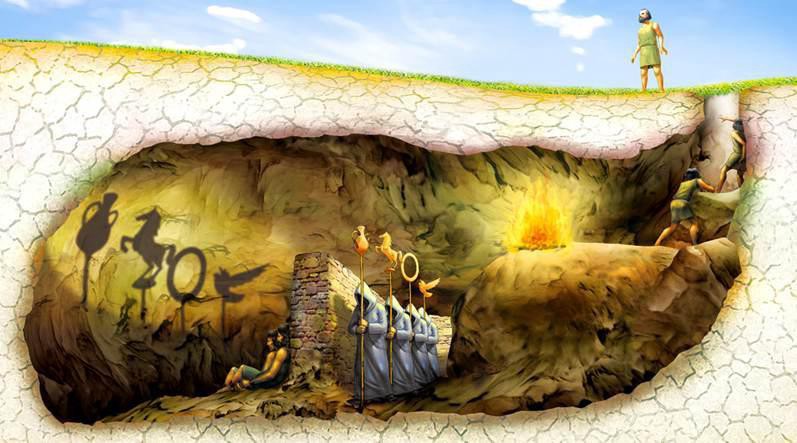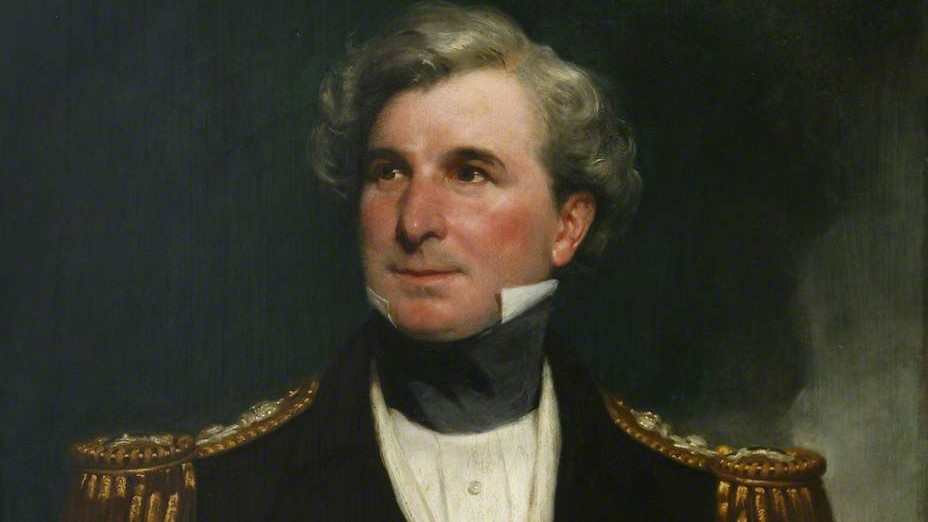The Philosophy of Analogies

In The Republic—after introducing ‘the analogy of the sun’, in which the idea of goodness ‘illuminates’ truth, and ‘the analogy of the divided line’—Plato presents ‘the Allegory of the Cave’ (depicted above). Prisoners in an underground cave are chained by the neck and legs, their eyes fixed towards a wall onto which shadows are cast. Trusting their senses, these two-dimensional figures mark the prisoners’ reality. But this imaginary world does not represent the intelligible reality above it: the ‘world of ideas’. Like the prisoners, we can only hope to understand reality by ascending out of the cave. Plato’s analogies are powerful. But is each story, the source, really consistent with its accompanying theory, the target of the analogy?
Recently I was reading a book about writing poetry. In it the author describes how the trick to writing good poetry is to be authentic. And how do you be authentic? You dip into your subconscious, to retrieve your inner voice, as a bucket is dipped into a well, to retrieve water. By honing your poetic skills (use of metre, assonance, metaphors … ) you construct a serviceable bucket (deep and has no holes) to fish out what you really have to say.
Are analogies like this helpful? I’m yet to decide but I‘ve always taken a dislike to them. If I say one thing is like another thing, what am I really saying about the thing I hope to describe? Nothing—so I’ve always thought: the analogy only gives the impression that the two are related.
Sure, analogies are helpful, loosely speaking. They induce intuition about or ‘understanding’ of a thing by making use of another thing. They’ve a long history in philosophy. With the ‘Allegory of the Cave’ Plato posits similarities between a cave and reality. In the latter half of the 20th century an analogy between mind and computer was popular, according to which the brain, as hardware, handles information like a computer does (cf. functionalism). However, analogies tend to offer oversimplifications which can turn out to be wrong. Metaphorically, they rely on an ambiguity which is impermissible in disciplines such as science, law, and philosophy.
So you dislike them too, right?
Right?
In a cruel turn of events, to where has my recent research led me? You guessed it: to analogy. O, how the world punishes me. In my PhD I’ve entered one of the many rabbit holes of analytic metaphysics by examining the claim that grounding, a relation between less- and more-fundamental entities in metaphysical explanation, is like causation, a relation between events in causal explanation—where ‘is like’ is doing some heavy metaphysical lifting. How are grounding and causation alike? They’re analogous, some say. I’m sceptical.
I’m far from offering any comprehensive answers to the question. Before I get there I’d like to understand analogies in a more-general sense.
Will they redeem themselves to me? In their use is there some abstract, metaphysical magic at work which I cannot fathom? Let’s see.
As metaphors

The poet who writes, ‘I am the captain of my soul’, expresses that the relation between them and their soul is similar to the relation between a captain and their ship (Alasdair Macintyre’s example). Pictured is my distant relative, polar explorer, and ‘handsomest man in the Navy’, James Clark Ross (1800–1862), with whom I share a name. According to the poet’s analogy, we both captain our souls. However, only Sir James captained a ship. (Henry William Pickersgill)
An analogy is an asserted similarity between two objects of comparison. Let’s call these objects the source, S, and the target, T. The hope of drawing an analogy is to induce an understanding—or intuition—about T by mapping S’s features onto it.
Analogies come in many forms. As metaphors they lend creative support to comparisons: literary devices which express similarities in the form ‘T is like S’ (‘Life is like a box of chocolates’). An analogy implies S and T carry something similar (in both cases you just never know what you’re gonna get!), thus justifying its use. Analogies of this metaphorical kind are used pervasively. In fact, I’ve laced this article with them, being careful not to water down my points too much …
Though the use of metaphors is inescapable—or so some people think—the creative sense in which they’re used permits a sort of vagueness which I cannot always forgive in intellectual contexts. In driving an incumbent feeling or intuition home, however, I’m all for them. Consider this wonderful metaphor by Simon Blackburn in ‘Symposium: realism and truth. Wittgenstein, Wright, Rorty, Minimalism’:
There are a few metaphors written into this passage. The central one is the river (S) of pragmatism (T): a stick in the former is Blackburn’s counterargument against the latter. Personally, I like this piece of writing and the literary devices contained within it. Blackburn’s objective is clear and only reaffirmed by the mental image of a stick, against all odds, meeting other sticks, which, one by one, form a dam. The metaphor is sound, creates neither confusion nor deception, and is aligned with the overall metaphilosophical point.
In contrast, the use of analogies can be pernicious when the similarity between S and T is tenuous. Room for fiction is provided in a metaphorical space in which spurious claims can be made. For example, our orientation towards the COVID-19 pandemic (T) has been described as a ‘war’ against the disease (S) by journalists. This language of war unhelpfully gives rise to the mental image of only strong people dying, which inhibits our lucid seeing of the pandemic as a healthcare crisis, not an ideological one.
Another example: a politician likens their capitalistic ideology (T) to running a farm (S). On this fictional farm workers breed and rear their own cows, the favoured option of the politician, instead of relying on the state’s cows for milk. Such a metaphor obfuscates the true reality of the situation in being contrived from a false assumption of similarity between S and T. By contrast, Blackburn’s metaphor is effective because it reinforces an already-simple idea without distorting it. Effective metaphors like this are faithful to the object of interest’s features, there’s a shared framework of ideas about them, and the scope is not overly ambitious.
As guiding lights

This is an image of the supermassive black hole at the centre of the M87 galaxy. Apparently, thermal aspects of Hawking radiation released from black holes can be studied in experiments involving plain old water. ‘White holes’ (S) in surface-water waves are created whose boundaries are analogous to event horizons of black holes (T). (Event Horizon Telescope project)
A good analogy illuminates something about T. But in what ways are analogies illuminating?
To be fair to the damned things, they serve a useful epistemic purpose. In hypothetical form, they trace out potential features of T based on features of S: S’s having these features offers plausibility to T’s having these features. The analogy will then be backed by (or not) proof (e.g., collection of empirical evidence, wide acceptance of argument, convergence of theory). As such, the tree of analogy [ahem], grown from a simple comparison, eventually bears fruit in the form of knowledge or belief about T.
There have been many cases of analogy in science which were proven successful. Here are two: Priestley correctly proposed that electrostatic force (T) follows the inverse-square law, just like gravity does (S), because gravity also exerts zero force inside a hollow shell of uniform density; Darwin was guided by way of analogy in using the phenomenon of artificial selection (S) to argue for the phenomenon of natural selection (T).
Generally, analogies are parallel lines of reasoning which structure comparisons and give senses of unity through ‘A-is-like-B’ propositions. For example, in law analogical reasoning defines routes down which similar cases should be treated. There might be a case which involves protected speech (S) whose details can be applied, by way of analogy, to details of cases involving consent (T).
But there are philosophical questions to consider about all of these cases. Chiefly, how are the objects of analogy related? The act of using an analogy in disciplines, including science and law, suggests a stronger connection between S and T than that of similarity alone, say, some guiding metaphysical principles or shared form, structure, and function. In the cases above we might point to waves sharing mathematical features (for black holes), to certain processes in selective breeding (for natural selection), and to moral principles (for consent) as the connections.
To qualify as an analogy, however, we must refrain from using univocal language in the comparison, for there must be differences to discern. That is to say, each of S and T possesses its own nature; their natures are just related somehow. Note that this is the vocabulary of medieval theories of analogy. Maybe it can be of service.
Usually in these theories analogies are posited between things which exhibit varying degrees of proportionality or likeness to God, who expresses His reality in different but related ways. I’m not particularly compelled by doing metaphysics according to God (or any god, for that matter). Nonetheless, these theories show a neat way of ordering the terms of an analogy.
Take theories of attribution, according to which analogical terms share features in primary (metaphysically prior) and secondary (metaphysically posterior) senses. Consider the terms of the following group: {person, bodily organ, lean dinner, relationship}. A general meaning is shared across the group: healthy. However, we can only pick out an analogy if members have prior and posterior senses of healthy. For instance, a person is healthy in a primary sense and one of their organs is healthy in a secondary sense: the organ has functions which are conducive to the health of that person. By contrast, for each of the following members of ‘sharp’, {a shard of glass, a musical note, a flavour of wine}, there’s no analogy between the terms because there are no primary and secondary senses of ‘induces an unpleasant sensation’ between them.
Moving on—without a god or some other metaphysical power governing relations between things, I have a concern that can be boiled down to this: is there really a distinction between similarities and analogies? Or, to put it another way: why think there’s something metaphysically deep underpinning the objects of analogy?
Crude approximations

If you were born into an ancient world without access to books or sophisticated equipment, how would you explain the stars? One Greek philosopher, Anaximander, made a clever attempt at an explanation which was possibly inspired by the growth of bark on trees. Ultimately, it was shown to be very wrong. (Thirdman/Pexels)
I’ve another concern with analogies: they only seem to offer crude and opaque approximations which are eventually proven incorrect.
Recently I learned (from this book by Anthony Gottlieb) that pre-Socratic philosopher Anaximander (c.610–c.546 BC), way back in time, conceived of astronomical bodies as wheel-shaped rings of fire. These rings, so the theory goes, rotate round our non-spherical planet.
Despite how jazzy this sounds, Anaximander’s theory was actually quite ingenious. Anaximander argued that opposites compete to keep everything in balance. This maintained a consistency with the view that there was indeterminate nothing from which the cosmos arose. Hot and dry (e.g., the Sun) are born with moist and cold (i.e., Earth) and so forth.
So how did Anaximander explain those bright dots in the sky, which don’t look much like rings of fire rotating round Earth? Their light shines towards us through holes in intermediate mist, escaping through it like air out of a punctured bike tyre (Gottlieb’s analogy). It was an excellent piece of lateral thinking which was fuelled by inchoate mathematical imagination in the sense that everything had to be balanced. However, his theory is flawed for a plurality of obvious reasons. Anaximander was likely inspired by thinking of the cold Earth as shedding its heat as a tree sheds its bark, forming a mist between. It was therefore destined to fail from the start.
The use of analogies isn’t only a relic of ancient worlds. Take the history of atomic models in physics as a case study. Atoms used to be modelled as solid spheres, which bounce around like balls in an ideal gas. The model of the atom then evolved into a ‘plum pudding’, wherein ‘plums’ (electrons) are surrounded by the rest of the pudding (positive charge). Afterwards, physicists adopted a planetary model for the atom: electrons orbiting a nucleus like planets orbiting the Sun.
All of these models are now regarded as primitive. We follow quantum models according to which electron locations are represented as clouds (probability distributions), though we retained use of ‘orbit’ in our concept of angular momentum. Will this model stick? Each model before it wasn’t quite right enough and acted as a placeholder of disputable explanatory power for the next, each relying on the blunt tool of analogy.
Nevertheless, in general, analogies trace out features which can be tested or argued about in a structured way, sometimes improving our predictive power. And from this tiny selection of analogies, which I mined from the annals of physics, we can infer the sizeable impact of analogies on the discipline, on science as a whole (e.g., in medicine), and beyond.
A final thought
We meet our journey’s end. What shall my final view of analogies be?
We’ve encountered analogies which are metaphorical, scientific, legal, and metaphysical in kind. Upsides and downsides have been discussed.
Many of us are fond of using them. However, I fear that they do not provide explanations outside mental representations: that each is a product of a ‘taste in the head’, born in an inward impression of significance (Brown 1941). In so saying I’m aware I’ve returned to the rather negative and frustrated view with which I started; it’s like I’ve returned home without resolving anything on my quest. Perhaps I shall heed Freud and embrace them, too:
